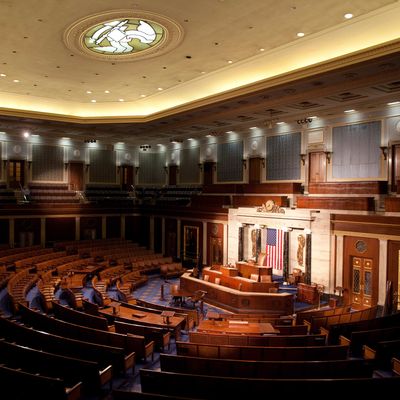
“The placement of placards or personal items is not allowed,” a disembodied voice is saying from the dais below me, to an empty House chamber. “Items are subject to removal by security and staff.” A quick glance around the House floor shows that the staff has their work cut out for them: In the third row from the front, a powder-blue cowboy hat sits in the seat closest to the aisle (the hat must belong to Florida Democrat Frederica Wilson, who’s famous for her collection). Across the row, someone has placed a pile of newspapers in two adjoining seats. Two rows back, one of the center aisle seats is taken with an oversize purse and tote bag. Others are held by winter coats and cardboard signs and place-savers made of printer paper. It’s still eight hours before the president will be here to deliver his second-to-last State of the Union address, but the members of Congress who want to get close to him need to show up early. Unlike the Supreme Court justices and other dignitaries who get reserved seating in the front rows, seats for Congress are first come, first served.
So every year, members who want to shake the president’s hand — or take a selfie with him, or even just be seen on the live feeds — show up early. Eliot Engel, whom ABC calls an “aisle hog,” is walking around, talking on his cell phone; so is Sheila Jackson Lee, who was dubbed queen of the aisle hogs by the Houston Chronicle last year. Steve Cohen is reading a newspaper in the back row. Reporters love to make fun of members of Congress for this behavior, but it’s perfectly understandable — the seating at the State of the Union is for most members a total free-for-all, one of the few aspects of the night that isn’t carefully choreographed. There was a brief period, following the shooting of Gabrielle Giffords, when lawmakers were asking members from the opposite party to sit with them at the State of the Union address. After this obviously empty display of bipartisanship failed to result in anything but awkward headlines — “Pelosi not sitting with Cantor, despite his invitation” — most members gave up on it.
The best place to be is in the First Lady’s viewing box, because those attendees are likely to get a personal shout-out from the president. They also hint at what the president will talk about. Tonight, there’s Malik Bryant, a 13-year-old boy from Chicago who wrote to Santa saying he wanted to be safe from gang violence; a community college student; a health-care worker; a wounded warrior; and Alan Gross, the USAID worker who was held in a Cuban prison for five years until Obama opened up relations with the country last month. (Emma Sulkowicz, the Columbia University student carrying her mattress around campus to protest the university’s handling of rape, will also be there as Kirsten Gillibrand’s guest.)
The White House has already indicated that the president will talk about the economic recovery, raising taxes on the wealthiest Americans to finance tax cuts for the middle class, about free community college and requiring paid sick leave for workers. They’ve also acknowledged that the State of the Union ritual has become less meaningful — thanks both to a Congress that has decided in advance to oppose the president’s legislative agenda and (maybe consequently) declining viewership. So they’ve already unveiled most of the meaningful proposals in his speech. That doesn’t mean the theatrics can’t be compelling: According to one lawmaker’s office, Obama will mention the Charlie Hebdo victims tonight, and members of Congress will hold up yellow pencils in their honor. As for what other spectacles might manifest, there’s only one thing lawmakers (and the rest of us) can do: sit around and wait.





























